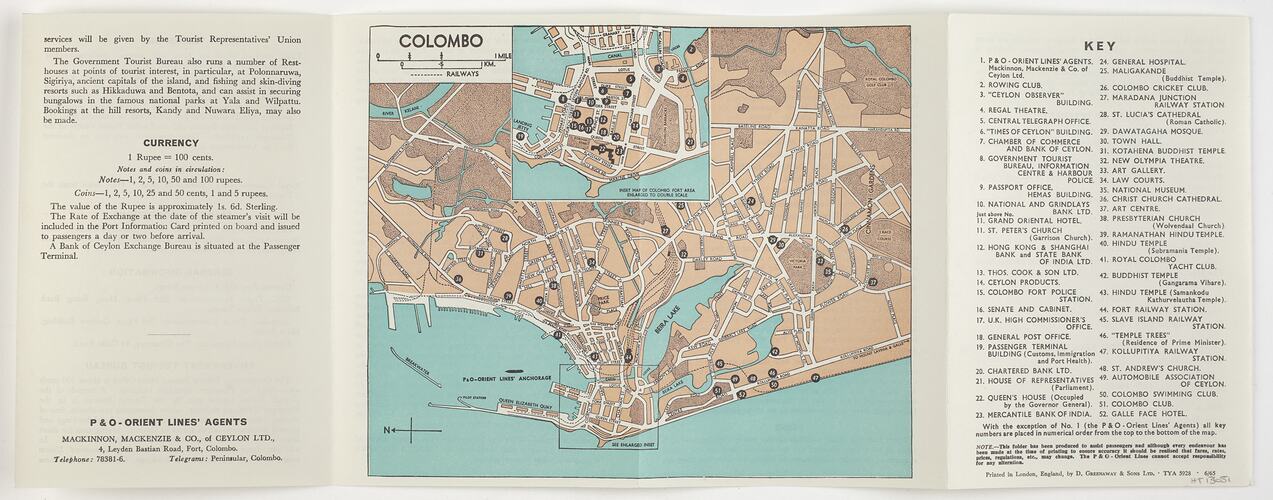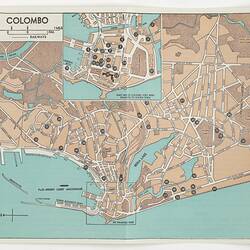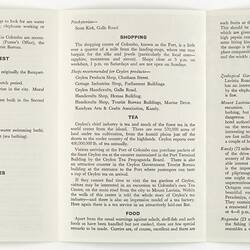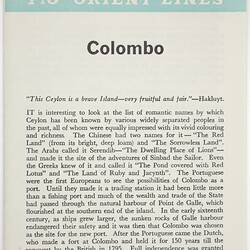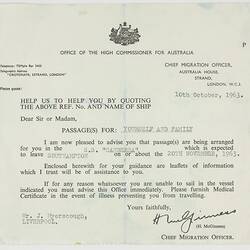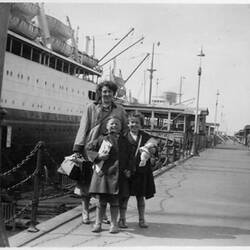Summary
Information leaflet issued to passengers by the P&O Orient Line. It provides details regarding the port of Colombo including history, places of interest, shopping, local food, hotels, entertainment, excursions, climate, transport, and currency. It also includes a map. The leaflet was issued to the Myerscough family during their migrant voyage from England to Australia in 1963 as part of their package of information materials, and kept as a souvenir of their shipboard experience.
John and Doreen Myerscough migrated to Australia from Liverpool in England with their daughters Jill and Julie on 20 November 1963. Searching for greater opportunities and with savings behind them, they took advantage of the Australian Government's 'Nest Egg Scheme'. They were also assisted ten pound migrants. The family sailed on the P&O Orient Line SS Canberra and settled in Melbourne where the climate was said to be similar to that of England. They transferred directly to Altona Migrant Hostel and ended up staying there (most unusually) for two years. John worked on the Geelong-Melbourne oil pipeline, in construction, and as a sub-contractor all over Victoria installing ceilings. Doreen had another baby Paul and later worked at Rothman's cigarette factory in Brooklyn. The couple purchased a block of land in Melton, promoted as a growth suburb, but the potential for isolation, as well as the couple's inability to really get ahead, made them decide to give up the dream and return to England. They paid their full fares, sold their land and returned to Liverpool on the P&O Orient Line SS Oriana on 21 January 1966. However, the challenges they experienced inspired them to strive and succeed, and John and Doreen have subsequently become frequent tourist visitors to Australia.
Physical Description
Soft card leaflet about Colombo, Ceylon (now Sri Lanka). Folds out to 72.5 cm. It has black text and a map in 3 colours. Front cover has 'P&O Orient Lines' in green. Printed in London by D Greenaway & Sons Ltd.
Significance
The Myerscough migration documents collection offers the unique opportunity to record the experiences of a migrant family who returned home. It is extremely difficult to capture the narratives of the people for whom migration was a negative or unsuccessful experience and who cut their losses and left. Return migration by its very nature is challenging to document through memory and material culture from the receiving country as people tend to be geographically distant, as well as frequently reluctant to record their negative experiences often accompanied by a sense of failure.
More Information
-
Collecting Areas
-
Acquisition Information
Donation from Mrs Doreen Myerscough, Mr John Myerscough, 17 Jan 2007
-
Past Owner or User
Mrs Doreen Myerscough, Melbourne, Greater Melbourne, Victoria, Australia, 1963
-
Past Owner or User
Mr John Myerscough, Melbourne, Greater Melbourne, Victoria, Australia, 1963
-
Inscriptions
Text: P&O-ORIENT LINES/Colombo.
-
Brand Names
-
Classification
-
Category
-
Discipline
-
Type of item
-
Overall Dimensions
18.9 cm (Length), 12.4 cm (Width)
-
Keywords
Migrant Hostels, Nest Egg Scheme, Return Migration, Shipping Lines
